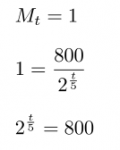Phenomniverse
New member
- Joined
- Aug 23, 2018
- Messages
- 21
My math tutor used the following example to demonstrate the idea of exponential decay:
Bismuth-210 has a half-life of 5.0 days.
a) Suppose a sample originally has a mass of 800mg. Find a formula for the mass remaining after t days.
b) Find the mass remaining after 30 days.
c) When is the mass reduced to 1mg?
He solved it using the formula P = P_0e^{-kt} where P_0 is the initial mass (800mg), t = 5 days and P = 400 (because we know that the mass will have reduced by half after 5 days) and then solving for k to work out what the decay constant is.
I proposed an easier solution, based on the idea that repetitive halving is the same as dividing by two to the power of n, where n is the number of times to halve the initial number. In this case, that will be t/5. So my formula was M_t=M_0/[2^(t/5)], where M_t represents the mass at time t, and M_0 represents the initial mass. My solution seems to work, but when it comes to part (c) from the example, I'm stuck as to how to solve for t.

How can I get that t on its own?
Bismuth-210 has a half-life of 5.0 days.
a) Suppose a sample originally has a mass of 800mg. Find a formula for the mass remaining after t days.
b) Find the mass remaining after 30 days.
c) When is the mass reduced to 1mg?
He solved it using the formula P = P_0e^{-kt} where P_0 is the initial mass (800mg), t = 5 days and P = 400 (because we know that the mass will have reduced by half after 5 days) and then solving for k to work out what the decay constant is.
I proposed an easier solution, based on the idea that repetitive halving is the same as dividing by two to the power of n, where n is the number of times to halve the initial number. In this case, that will be t/5. So my formula was M_t=M_0/[2^(t/5)], where M_t represents the mass at time t, and M_0 represents the initial mass. My solution seems to work, but when it comes to part (c) from the example, I'm stuck as to how to solve for t.

How can I get that t on its own?

